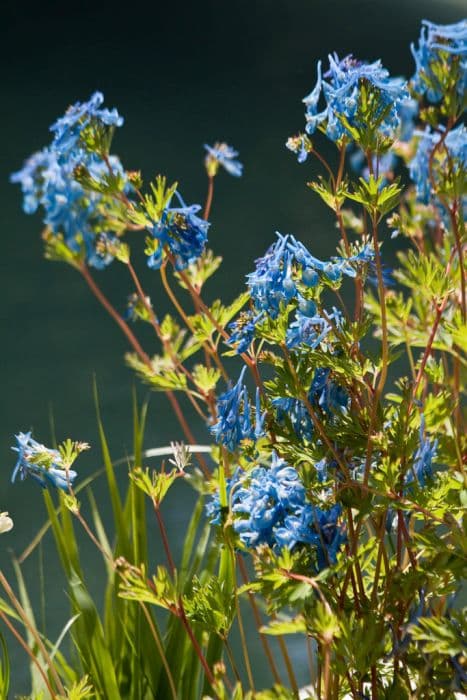Fumewort Corydalis solida subsp. solida 'Dieter Schacht'

ABOUT
The Corydalis solida subsp. solida 'Dieter Schacht', commonly known as Fumewort, is a charming perennial that boasts a delicate appearance. Its foliage is finely divided, offering a fern-like texture that adds a fresh, green backdrop. The leaves emerge in early spring, quickly making an impression with their intricate, lacey patterns. The real showstopper of Fumewort is its flowers, which come to life in stunning spires. Each flower spike carries a series of tubular blooms that nod gracefully on the stem. The 'Dieter Schacht' cultivar is particularly noted for its flowers, which display a rich, pinkish-purple hue. The blossoms are reminiscent of small breeches or pantaloons, hence the common name. They create a beautiful contrast against the verdant foliage, and they tend to attract attention in the garden with their vivid color and unique shape. Overall, Fumewort 'Dieter Schacht' makes for a delightful addition to woodland gardens or shaded areas where its ornamental leaves and eye-catching blooms provide visual interest and a burst of color in the early season. The plant conveys a cottage garden feel and can offer a touch of elegance to any planting scheme while remaining unmentioned in size.
About this plant
 Names
NamesFamily
Papaveraceae
Synonyms
Fumewort, Bird-in-a-Bush, Hollowroot
Common names
Corydalis solida (L.) Clairv.
 Toxicity
ToxicityTo humans
The plant commonly known as Fumewort can be toxic to humans if ingested. While cases of poisoning are rare, the plant contains alkaloids that can cause symptoms if consumed in significant quantities. Symptoms of Fumewort poisoning can include gastrointestinal upset, with possible nausea, vomiting, and diarrhea. CNS effects such as dizziness and confusion may occur due to the presence of toxic alkaloids. While it's uncommon for individuals to consume parts of the plant, care should be taken to avoid ingestion to prevent these possible adverse health consequences.
To pets
Fumewort is also potentially toxic to pets. Similar to humans, the alkaloids present in the plant can be harmful if ingested by animals. Symptoms of poisoning in pets may include gastrointestinal distress, such as vomiting and diarrhea, and can also affect the central nervous system, potentially causing tremors or seizures. It is advisable to keep pets away from Fumewort to prevent accidental ingestion and the associated risks.
 Characteristics
CharacteristicsLife cycle
Perennials
Foliage type
Deciduous
Color of leaves
Green
Flower color
Pink
Height
6 inches (15 cm)
Spread
6 inches (15 cm)
Plant type
Bulb
Hardiness zones
5
Native area
Europe
Benefits
 General Benefits
General Benefits- Aesthetic Appeal: Adds vibrant color to gardens with its striking purple or pink flowers, enhancing the visual appeal of the landscape.
- Pollinator Attraction: Attracts beneficial insects such as bees that pollinate flowers, supporting local ecosystems.
- Easy to Grow: Known for being low maintenance and easy to cultivate, making it ideal for amateur gardeners or those with limited time.
- Spring Blossoms: Being one of the early bloomers in spring, it brings life to gardens after winter and signals the start of the growing season.
- Ground Cover: Can be used effectively as ground cover in appropriate conditions, helping to reduce weed growth and soil erosion.
- Naturalizing: Has the ability to naturalize in some environments, spreading gradually to create a more lush garden space.
- Drought Resistance: Once established, exhibits tolerance to dry conditions, reducing the need for frequent watering.
 Medical Properties
Medical PropertiesThis plant is not used for medical purposes.
 Air-purifying Qualities
Air-purifying QualitiesThis plant is not specifically known for air purifying qualities.
 Other Uses
Other Uses- Corydalis solida 'Dieter Schacht', commonly known as Fumewort, can serve as a natural dye for textiles, giving fabrics a range of beautiful and subtle hues.
- Fumewort's tuber structure can be studied in botanical education to understand how plants store nutrients and survive in cold climates.
- The plant's ability to deter certain pests can make it a valuable companion plant in the garden to protect other plants.
- Fumewort's early spring bloom can be used by photographers and artists as a subject to capture the beauty of spring emergence.
- The plant can be used in landscape design to create natural woodland garden settings and shady rock garden arrangements.
- Enthusiasts of Fumewort can use its dried flowers for creating botanical prints on paper, a technique used in traditional arts and crafts.
- Fumewort can contribute to the study of pollinator behavior and ecology by providing early spring nectar to emerging bees.
- The plant’s visual appeal allows it to be used in floral arrangements and bouquets when fresh cut, although its brief flowering time requires timely harvesting.
- Fumewort seed pods can be used in dried decorative displays, where they provide an interesting shape and texture contrast to other elements.
- Culinary enthusiasts might use the flowers of Fumewort to garnish dishes, although it is not known to be widely consumed.
Interesting Facts
 Feng Shui
Feng ShuiThe Fumewort is not used in Feng Shui practice.
 Zodiac Sign Compitability
Zodiac Sign CompitabilityThe Fumewort is not used in astrology practice.
 Plant Symbolism
Plant Symbolism- Hope - Corydalis solida, commonly known as Fumewort, often blooms early in spring, symbolizing the hope and renewal that comes with the changing seasons.
- Resilience - Fumewort can endure and flourish in shady conditions, representing the ability to persevere through challenges and difficult times.
- Healing - Historically, Fumewort has been used in herbal medicine, which translates to its symbolic meaning of healing and soothing emotional or physical pain.
 Water
WaterThe Fumewort should be watered regularly during its growing season, ensuring the soil is kept moist but not waterlogged. It is best to water deeply once a week, providing about 1 to 1.5 gallons each time, depending on the weather conditions and the soil's ability to retain water. During the dormant period, after the foliage has died back, watering should be reduced significantly since the plant requires a drier resting phase. Overwatering during dormancy could lead to bulb rot.
 Light
LightFumewort thrives in partial shade to full shade conditions, away from direct afternoon sun. The best spot for this plant is under the canopy of deciduous trees where it can receive dappled sunlight or in a shaded garden area that mirrors its natural woodland habitat. Too much direct sun can scorch the leaves, while too little can impede flowering.
 Temperature
TemperatureFumewort prefers a temperate environment, thriving best in a temperature range between 50°F and 70°F. It can tolerate a minimum temperature of as low as 32°F during its dormant winter period but should be protected from prolonged freezing temperatures. The ideal conditions involve cool to moderate temperatures, as excessively high temperatures can stress the plant.
 Pruning
PruningPruning Fumewort is not typically necessary, but you may remove spent flowers after blooming to encourage tidiness and potentially a second bloom. If the foliage becomes unsightly in summer, as it often goes dormant, it can be cut back. The best time for any pruning is after flowering and when the leaves begin to yellow and die back.
 Cleaning
CleaningAs needed
 Soil
SoilFumewort thrives in a fertile, moist, well-draining soil mix with a pH around 6.0 to 7.5. A blend of loamy garden soil, leaf mold or compost, and coarse sand or perlite ensures proper drainage and fertility.
 Repotting
RepottingFumewort is typically not repotted often as it is a perennial and can be left undisturbed for several years. Repot only when the plant outgrows its current container or every 3-4 years.
 Humidity & Misting
Humidity & MistingFumewort prefers a moderate humidity level. However, it is not particularly sensitive to humidity and can tolerate the average ambient moisture found in most outdoor garden environments.
 Suitable locations
Suitable locationsIndoor
Provide shade, cool temps, moist soil.
Outdoor
Semi-shade, cool spot, rich, moist soil.
Hardiness zone
4-9 USDA
 Life cycle
Life cycleThe life cycle of Corydalis solida, commonly known as Fumewort, begins with seed germination in late spring or early summer, as soil temperatures increase. After germination, the plant develops a rosette of leaves and a root system through the summer. In the fall, it enters a period of dormancy where above-ground growth dies back, and the plant survives underground as a tuber. Come spring, Fumewort emerges again, producing flowering stalks with clusters of purple, pink, or white flowers that are pollinated by insects. Following pollination, the plant sets seed, which are dispersed by ants attracted to their fleshy appendages, completing the reproductive cycle. As a perennial, Fumewort can continue this life cycle for several years, with the tuber growing larger and potentially dividing to form new plants.
 Propogation
PropogationPropogation time
Spring
Propogation: The most popular method of propagating Corydalis solida, commonly known as Fumewort, is through its tubers. This can be done after the plant has finished flowering and the foliage has died back, usually in late spring to early summer. Gardeners should carefully dig up the tubers and gently separate them, ensuring each piece has at least one growth point. These divisions can then be immediately replanted in well-draining soil at a depth of about an inch (2.54 cm). The new plants will typically emerge the following spring to start the cycle anew. This method of vegetative propagation is favored due to its simplicity and effectiveness in producing true to type offspring.









